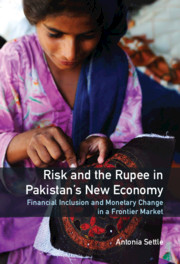 Risk and the Rupee in Pakistan's New Economy
Risk and the Rupee in Pakistan's New Economy Published online by Cambridge University Press: 31 March 2020
As Chapter 3 shows, the liberalisation process has shifted the pricing regime on money and on key commodities from set pricing and comprehensive intervention towards a market float. This process has by no means been absolute. The rupee itself, together with the key prices of wheat and electricity, continues to be subjected to intervention that seeks to smooth volatility. The wheat price is influenced by the continuing but much pared-down programme of state procurement. Electricity is still priced in accordance with tariffs set by the state, although these have moved much closer to global prices, both in terms of the rupee price and in terms of much more frequent tariff revision. Regardless of these vestiges of the pre-liberalisation era, however, transformation in the economy has been significant and this transformation extends to the monetary environment – the governance of money and of the prices that give everyday meaning to the usefulness of money.
Applying the analytical framework developed in Chapter 2, this chapter contends that the new economy is characterised by complex and persistent instability. This instability reaches into the everyday transactions entailed in maintaining the consumer basket and thereby imposes very real implications for money. Building on the description of the transformation of the rupee relayed in Chapter 3 with a description of attendant transformation in alternative monetary forms, which were raised in Chapter 5, the chapter presents a conception of frontier money as entailing multiple money forms, each with its own profile of risk and liquidity, that include the transformed open economy rupee as well as an array of alternative money forms.
This analysis is premised on the changing risk profile of the rupee in the postliberalisation environment of the new economy. If state money is not the ‘stable pole’, then it carries risk of volatility in its value relative to subsistence goods, as well as the risk of long-term depreciation. In these conditions, the risk-free status of state money is undermined as the monetary environment becomes more complicated. In these circumstances, state money's distinction from other liquid assets becomes less pronounced: the once clear line is increasingly blurred between state money – as an embodiment of key monetary attributes and thus a unique money instrument – and ordinary commodities and assets which may carry similar profiles of risk and liquidity.
To save this book to your Kindle, first ensure no-reply@cambridge.org is added to your Approved Personal Document E-mail List under your Personal Document Settings on the Manage Your Content and Devices page of your Amazon account. Then enter the ‘name’ part of your Kindle email address below. Find out more about saving to your Kindle.
Note you can select to save to either the @free.kindle.com or @kindle.com variations. ‘@free.kindle.com’ emails are free but can only be saved to your device when it is connected to wi-fi. ‘@kindle.com’ emails can be delivered even when you are not connected to wi-fi, but note that service fees apply.
Find out more about the Kindle Personal Document Service.
To save content items to your account, please confirm that you agree to abide by our usage policies. If this is the first time you use this feature, you will be asked to authorise Cambridge Core to connect with your account. Find out more about saving content to Dropbox.
To save content items to your account, please confirm that you agree to abide by our usage policies. If this is the first time you use this feature, you will be asked to authorise Cambridge Core to connect with your account. Find out more about saving content to Google Drive.